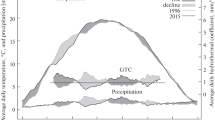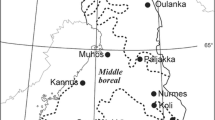Abstract
Analysis of observational phenological data has indicated that the length of the vegetation period (VP), here defined as the time between leaf onset and leaf colouring (LC), has increased in the last decades in the northern latitudes mainly due to an advancement of bud burst. Analysing the patterns of spring phenology over the last century (1880–1999) in Southern Germany showed that the strong advancement of spring phases, especially in the decade before 1999, is not a singular event in the course of the 20th century. Similar trends were also observed in earlier decades. Distinct periods of varying trend direction for important spring phases could be distinguished. Marked differences in trend direction between early and late spring phases were detected, which can be explained by different trends in March and April mean temperatures. The advancement of spring phenology in recent decades is part of the multi-decadal fluctuations over the 20th century that vary with the species and the relevant seasonal temperatures. However, for all Natural Regions in Germany, spring phases were advanced by about 5–20 days on average between 1951 and 1999, LC was delayed between 1951 and 1984, but advanced after 1984 for all considered tree species and the length of the VP increased between 1951 and 1999 for all considered tree species by an average of 10 days throughout Germany.






Similar content being viewed by others
References
Badeck F-W, Bondeau A, Böttcher K, Doktor D, Lucht W, Schaber J, Sitch S (2004) Responses of spring phenology to climate change. New Phytologist 162:295–309
Böhm R, Auer I, Brunetti M, Maugeri M, Nanni T, Schoner W (2001) Regional temperature variability in the European Alps: 1760–1998 from homogenized instrumental time series. Int J Climatol 21:1779–1801
Chen WJ, Black TA, Yang PC, Barr AG, Neumann HH, Nesic Z, Blanken PD, Novak MD, Eley J, Ketler RJ, Cuenca A (1999) Effects of climatic variability on the annual carbon sequestration by a boreal aspen forest. Global Change Biol 5:41–53
Chmielewski F-M, Rötzer T (2001) Response of tree phenology to climate change across Europe. Agric For Meteorol 108:101–112
Chuine I (2000) A unified model for budburst of trees. J Theor Biol 207:337–347
Crick H, Sparks T (1999) Climate change related to egg-laying trends. Nature 399:423–424
Gerstengarbe FW, Werner PC (1999) Estimation of the beginning and end of recurrent events within a climate regime. Clim Res 11:97–107
Goulden ML, Munger JW, Fan S-M, Daube BC, Wofsy SC (1996) Exchange of carbon dioxide by a deciduous forest: response to interannual climate variability. Science 271:1576–1578
Häkkinen R, Linkosalo T, Hari P (1995) Methods for combining phenological time series: application to bud burst in birch (B. pendula) in Central Finland for the period 1896–1955. Tree Physiol 15:721–726
Keeling CD, Chin JFS, Whorf TP (1996) Increased activity of northern vegetation inferred from atmospheric CO2 measurements. Nature 382:146–149
Kendall M, Gibbons JD (1990) Rank correlation methods. E. Arnold, London, 260 pp
Kramer K (1994) Selecting model to predict the onset of growth of Fagus sylvatica. J Appl Ecol 31:172–181
Kramer K, Mohren GMJ (1996) Sensitivity of FORGRO to climatic change scenarios: a case study of Betula pubescens, Fagus sylvativa and Quercus robur in the Netherlands. Clim Change 34:231–237
Linkosalo T, Hakkinen R, Hari P (1996) Improving the reliability of a combined phenological time series by analyzing observation quality. Tree Physiol 16:661–664
Menzel A (2000) Trends in phenological phases in Europe between 1951 and 1996. Int J Biometeorol 44:76–81
Menzel A (2003) Plant phenological anomalies in Germany and their relation to air temperature and NAO. Clim Change 57:243–263
Menzel A, Fabian P (1999) Growing season extended in Europe. Nature 397:659–659
Menzel A, Estrella N, Fabian P (2001) Spatial and temporal variability of the phenological seasons in Germany from 1951 to 1996. Global Change Biol 7:657–666
Meynen E, Schmithüsen J, Gellert J, Neef E, Müller-Miny H, Schultze JH (1962) Handbuch der naturräumlichen Gliederung Deutschlands. Bundesanstalt für Landeskunde und Raumforschung, Bad Godesberg, 608 pp
Myneni RB, Keeling CD, Tucker CJ, Asrar G, Nemani RR (1997) Increased plant growth in the northern latitudes from 1981 to 1991. Nature 386:698–702
Parmesan C, Yohe G (2003) A globally coherent fingerprint of climate change impacts across natural systems. Nature 421:37–42
Peñuelas J, Filella I (2001) Phenology—responses to a warming world. Science 294:793–795
Peñuelas J, Filella I, Comas P (2002) Changed plant and animal life cycles from 1952 to 2000 in the Mediterranean region. Global Change Biol 8:531–544
Root TL, Price JT, Hall KR, Schneider SH, Rosenzweig C, Pounds JA (2003) Fingerprints of global warming on wild animals and plants. Nature 421:57–60
Schaber J (2002) Phenology in Germany in the 20th century: methods, analyses and models. Thesis, University of Potsdam, p 146. http://pub.ub.uni-potsdam.de/2002/0022/schaber.pdf
Schaber J, Badeck FW (2002) Evaluation of methods for the combination of phenological time series and outlier detection. Tree Physiol 22:973–982
Scheifinger H, Menzel A, Koch E, Peter C, Ahas R (2002) Atmospheric mechanisms governing the spatial and temporal variability of phenological phases in central Europe. Int J Climatol 22:1739–1755
Schnelle F, Volkert E (1957) Vorschläge zur Errichtung ’Internationaler Phänologischer Gärten’ als Stationen eines Grundnetzes für internationale phänologischen Beoachtungen. Meteorologische Rundschau 10:130–133
Schnelle F, Witterstein F (1952) Beiträge zur Phänologie Deutschlands II. Tabellen phänologischer Einzelwerte von etwas 500 Stationen der Jahre 1936 bis 1944. Berichte des Deutschen Wetterdienstes in der US-Zone, 95, Deutscher Wetterdienst, Bad Kissingen, p 120
Schnelle F, Witterstein F (1964) Beiträge zur Phänologie Deutschlands IV. Tabellen phänologischer Einzelwerte von etwas 500 Stationen der Jahre 1922 bis 1935. Berichte des Deutschen Wetterdienstes, 95, Deutscher Wetterdienst, Offenbach a. M., 123 pp
Schönwiese C-D, Rapp J (1997) Climate trend atlas of Europe: based on observations 1891–1990. Kluwer, Dortrecht, 228 pp
Sneyers R (1990) On the statistical analysis of series of observations, 143. World Meteorological Organization, Geneva, 192 pp
Sparks TH, Jeffree EP, Jeffree CE (2000) An examination of the relationship between flowering times and temperature at the national scale using long-term phenological records from the UK. Int J Biometeorol 44: 82–87
White MA, Running SW, Thornton PE (1999) The impact of growing-season length variability on carbon assimilation and evapotranspiration over 88 years in the eastern US deciduous forest. Int J Biometeorol 42:139–145
Acknowledgements
The University Special Program HSP3 of the state Brandenburg supported this work. We thank the GWS for access to the phenological data and Mrs. Polte-Rudolf (GWS) for her support concerning the database.
Author information
Authors and Affiliations
Corresponding author
Rights and permissions
About this article
Cite this article
Schaber, J., Badeck, FW. Plant phenology in Germany over the 20th century. Reg Environ Change 5, 37–46 (2005). https://doi.org/10.1007/s10113-004-0094-7
Received:
Accepted:
Published:
Issue Date:
DOI: https://doi.org/10.1007/s10113-004-0094-7




